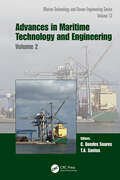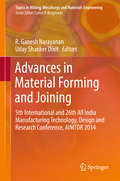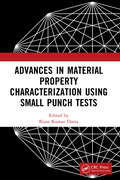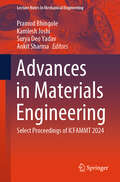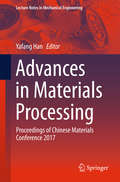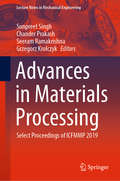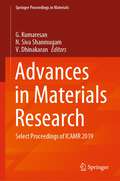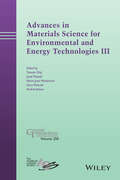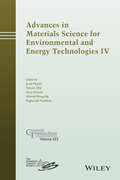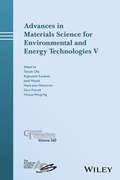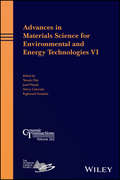- Table View
- List View
Advances in Maritime Technology and Engineering: Volume 2 (Proceedings in Marine Technology and Ocean Engineering)
by C. Guedes SoaresAdvances in Maritime Technology and Engineering comprises a collection of the papers presented at the 7th International Conference on Maritime Technology and Engineering (MARTECH 2024) held in Lisbon, Portugal, on 14-16 May 2024. This Conference has evolved from the series of biannual national conferences in Portugal, which have become an international event, reflecting the internationalization of the maritime sector and its activities. MARTECH 2024 is the seventh of this new series of biannual conferences. This book comprises 142 contributions that were reviewed by an International Scientific Committee.Advances in Maritime Technology and Engineering is dedicated to maritime transportation, ports as well as maritime safety and reliability. It further comprises sections dedicated to ship design, cruise ship design, and to the structural aspects of ship design, such as ultimate strength and composites, subsea structures as pipelines, and to ship building and ship repair.The Proceedings in Marine Technology and Ocean Engineering series is dedicated to the publication of proceedings of peer-reviewed international conferences dealing with various aspects of “Marine Technology and Ocean Engineering”. The series includes the proceedings of the following conferences: the International Maritime Association of the Mediterranean (IMAM) conferences, the Marine Structures (MARSTRUCT) conferences, the Renewable Energies Offshore (RENEW) conferences and the Maritime Technology (MARTECH) conferences. The “Marine Technology and Ocean Engineering” series is also open to new conferences that cover topics on the sustainable exploration of marine resources in various fields, such as maritime transport and ports, usage of the ocean including coastal areas, nautical activities, the exploration and exploitation of mineral resources, the protection of the marine environment and is resources, and risk analysis, safety and reliability. The aim of the series is to stimulate advanced education and training through the wide dissemination of the results of scientific research.
Advances in Material Forming and Joining: 5th International and 26th All India Manufacturing Technology, Design and Research Conference, AIMTDR 2014 (Topics in Mining, Metallurgy and Materials Engineering)
by Uday Shanker Dixit R. Ganesh NarayananThis edited book contains extended research papers from AIMTDR 2014. This includes recent research work in the fields of friction stir welding, sheet forming, joining and forming, modeling and simulation, efficient prediction strategies, micro-manufacturing, sustainable and green manufacturing issues etc. This will prove useful to students, researchers and practitioners in the field of materials forming and manufacturing.
Advances in Material Property Characterization using Small Punch Tests
by Bijan Kumar DuttaThe small punch test (SPT) is useful to calculate changes in the tensile and fracture properties of structural materials during the service life of the materials of plant components. This book compiles advances in the development of correlations to calculate mechanical properties of the materials using SPT data. New correlations have been developed using hybrid methodology involving analytical and experimental data. The newly developed correlations have been tested conducting case studies on SPT and pre- cracked/ notched SPT (p- SPT) specimens. The eventual applications of all the new correlations have been demonstrated by conducting a real- life case study involving degradation of structural material from ductile to semi- brittle state due to aging.Features:• Presents exclusive material on the remnant life assessment of in- service materials using SPTs.• Assesses the fracture toughness of ductile materials using the experimentally measured biaxial fracture strain.• Provides new equations to calculate the yield and ultimate stresses of copper and titanium alloys using measured SPT data.• Explores functions to correlate the load- displacement data of p- SPT specimens with fracture properties.• Includes case studies with direct relevance to the degradation of plant materials.This book is aimed at researchers, professionals, and graduate students in materials science and engineering, mechanical property characterization and testing, and small- scale experimentation. It is expected that the advanced methodology presented in this book to evaluate changes in the properties of aged materials during the service life using SPT data are useful to designers for safety evaluation and also to calculate the remaining service life of industrial components for life extension studies.
Advances in Material Science and Engineering: Selected Articles from ICMMPE 2021 (Lecture Notes in Mechanical Engineering)
by Mokhtar Awang Seyed Sattar Emamian Jeeferie Abd Razak Patrick J. MassetThis book highlights the recent research works on mechanical, manufacturing and plant engineering presented during the 7th International Conference on Mechanical, Manufacturing and Plant Engineering (ICMMPE 2021) held on 29th November 2021. It highlights the latest advances in the emerging areas, brings together researchers and professionals in the field and provides a valuable platform for exchanging ideas and fostering collaboration. Addressing real-world problems concerning joining technologies that are at the heart of various manufacturing sectors, the respective papers present the outcomes of the latest experimental and numerical work on problems in soldering, arc welding and solid-state joining technologies.
Advances in Material Science and Engineering: Selected Articles from ICMMPE 2022 (Proceedings in Technology Transfer)
by Mokhtar Awang Seyed Sattar Emamian Hussain H. Al-Kayiem Ton C. BorThis book highlights the recent research works on mechanical, manufacturing and plant engineering presented during the 8th International Conference on Mechanical, Manufacturing and Plant Engineering (ICMMPE 2022) held on November 24, 2022 in Kuala Lumpur, Malaysia. It highlights the latest advances in the emerging areas, brings together researchers and professionals in the field and provides a valuable platform for exchanging ideas and fostering collaboration. Addressing real-world problems concerning joining technologies that are at the heart of various manufacturing sectors, the respective papers present the outcomes of the latest experimental and numerical work on problems in soldering, arc welding and solid-state joining technologies.
Advances in Material Science and Engineering: Selected articles from ICMMPE 2020 (Lecture Notes in Mechanical Engineering)
by Mokhtar Awang Seyed Sattar EmamianThis book presents selected papers from the 6th International Conference on Mechanical, Manufacturing and Plant Engineering (ICMMPE 2020), held virtually via Google Meet. It highlights the latest advances in the emerging area, brings together researchers and professionals in the field and provides a valuable platform for exchanging ideas and fostering collaboration. Joining technologies could be changed to manufacturing technologies. Addressing real-world problems concerning joining technologies that are at the heart of various manufacturing sectors, the respective papers present the outcomes of the latest experimental and numerical work on problems in soldering, arc welding and solid-state joining technologies.
Advances in Material Science and Engineering: Selected articles from ICMMPE 2023, 16-Nov, Putrajaya, Malaysia (Proceedings in Technology Transfer)
by Mokhtar Awang Hussain H. Al-Kayiem Sattar S. EmamianThis book presents the latest research advancements in the field of material science, specifically in mechanical, manufacturing, and plant engineering. It includes peer reviewed articles from the 9th International Conference on Mechanical, Manufacturing and Plant Engineering (ICMMPE 2023) held on 16th November 2023 at The Everly Hotel Putrajaya, Malaysia. The conference showcases cutting-edge research and facilitates knowledge exchange among experts in the field of material science, mechanical engineering and their applications.
Advances in Material Science and Metallurgy: Select Proceedings Of Icfammt 2022 (Lecture Notes In Mechanical Engineering)
by Sunkulp Goel Bhingole Pramod P. Ulkesh B. DesaiThis book presents the select peer-reviewed proceedings of the International Conference on Futuristic Advancements in Materials, Manufacturing and Thermal Sciences (ICFAMMT 2022). It provides an overview of the latest research in the areas of fundamentals of material science and metallurgy, material processing, mechanical properties and material characterizations, composite materials, nanomaterials, applications of materials, advanced engineering materials, technologies for space, nuclear and aerospace applications, optimization of materials for required properties, resent trends in materials science and metallurgy. The book will be useful for researchers and professionals working in the field of material science and metallurgy.
Advances in Material Science and Metallurgy: Select Proceedings of ICFAMMT 2022 (Lecture Notes in Mechanical Engineering)
by Sunkulp Goel Bhingole Pramod P. Ulkesh B. DesaiThis book presents the select peer-reviewed proceedings of the International Conference on Futuristic Advancements in Materials, Manufacturing and Thermal Sciences (ICFAMMT 2022). It provides an overview of the latest research in the areas of fundamentals of material science and metallurgy, material processing, mechanical properties and material characterizations, composite materials, nanomaterials, applications of materials, advanced engineering materials, technologies for space, nuclear and aerospace applications, optimization of materials for required properties, resent trends in materials science and metallurgy. The book will be useful for researchers and professionals working in the field of material science and metallurgy.
Advances in Material Sciences and Engineering (Lecture Notes in Mechanical Engineering)
by Mokhtar Awang Seyed Sattar Emamian Farazila YusofThis book presents selected papers from the 4th International Conference on Mechanical, Manufacturing and Plant Engineering (ICMMPE 2018), which was held in Melaka, Malaysia from the 14th to the 15th of November 2018. The proceedings discuss genuine problems concerning joining technologies that are at the heart of various manufacturing sectors. In addition, they present the outcomes of experimental and numerical works addressing current problems in soldering, arc welding and solid-state joining technologies.
Advances in Materials Engineering and Manufacturing Processes: Select Proceedings of ICFTMM 2019 (Lecture Notes on Multidisciplinary Industrial Engineering)
by Inderdeep Singh Pramendra Kumar Bajpai Kuldeep PanwarThis book comprises select proceedings of the International Conference on Futuristic Trends in Materials and Manufacturing (ICFTMM) 2019. It covers latest findings and challenges in manufacturing processes and characterization of different advanced materials. Latest fabrication techniques of polymer based materials, biomaterials, and energy materials along with their practical applications are discussed. The contents also focus on cost-effective and energy-efficient sustainable and green manufacturing technologies. The contents of this book will be useful for students, researchers as well as industry professionals interested in characterization and fabrication of materials.
Advances in Materials Engineering: Select Proceedings of ICFAMMT 2024 (Lecture Notes in Mechanical Engineering)
by Ankit Sharma Pramod Bhingole Kamlesh Joshi Surya Deo YadavThe book presents select peer-reviewed proceedings of the International Conference on Futuristic Advancements in Materials, Manufacturing, and Thermal Sciences (ICFAMMT 2024). It covers latest research and developments in the field of material science and metallurgy. Various topics covered in this book are material processing, mechanical properties, and material characterisation, composite materials, nanomaterials, advanced engineering materials, and technologies for space, nuclear, and aerospace applications. The book also focuses on the optimisation of materials for required properties and recent trends in materials science and metallurgy. This book is of great value for researchers and professionals working in the field of material science and metallurgy.
Advances in Materials Processing and Manufacturing Applications: Proceedings of iCADMA 2020 (Lecture Notes in Mechanical Engineering)
by Amar Patnaik Ernst Kozeschnik Vikas KukshalThis book presents selected papers from the International Conference on Advances in Materials Processing and Manufacturing Applications (iCADMA 2020), held on November 5–6, 2020, at Malaviya National Institute of Technology, Jaipur, India. iCADMA 2020 proceedings is divided into four topical tracks – Advanced Materials, Materials Manufacturing and Processing, Engineering Optimization and Sustainable Development, and Tribology for Industrial Application.
Advances in Materials Processing: Proceedings Of Chinese Materials Conference 2017 (Lecture Notes In Mechanical Engineering)
by Yafang Han<P>This proceedings volume gathers selected papers presented at the Chinese Materials Conference 2017 (CMC2017), held in Yinchuan City, Ningxia, China, on July 06-12, 2017. <P> This book covers a wide range of material surface science, advanced preparation and processing technologies of materials, high purity materials, silicon purification technology, solidification science and technology, performance and structure safety of petroleum tubular goods and equipment materials, materials genomes, materials simulation, computation and design. <P> The Chinese Materials Conference (CMC) is the most important serial conference of the Chinese Materials Research Society (C-MRS) and has been held each year since the early 1990s. The 2017 installment included 37 Symposia covering four fields: Advances in energy and environmental materials; High performance structural materials; Fundamental research on materials; and Advanced functional materials. More than 5500 participants attended the congress, and the organizers received more than 700 technical papers. Based on the recommendations of symposium organizers and after peer reviewing, 490 papers have been included in the present proceedings, which showcase the latest original research results in the field of materials, achieved by more than 300 research groups at various universities and research institutes.
Advances in Materials Processing: Select Proceedings of ICFMMP 2019 (Lecture Notes in Mechanical Engineering)
by Seeram Ramakrishna Chander Prakash Sunpreet Singh Grzegorz KrolczykThis book presents the select proceedings of the International Conference on Functional Material, Manufacturing and Performances (ICFMMP) 2019. The book primarily covers recent research, theories, and practices relevant to surface engineering and processing of materials. It focuses on the lesser-known technologies and advanced manufacturing methods which may not be standardized yet but are highly beneficial to material and manufacturing industrial engineers. The book includes current advances in the field of coating, deposition, cladding, nanotechnology, surface finishing, precision machining, processing, and emerging advanced manufacturing technologies which enhance the performance of materials in terms of corrosion, wear and fatigue. The book can be a valuable reference for beginners, researchers, and professionals interested in materials processing and allied fields.
Advances in Materials Research: Select Proceedings of ICAMR 2019 (Springer Proceedings in Materials #5)
by N. Siva Shanmugam G. Kumaresan V. DhinakaranThis book comprises select peer-reviewed proceedings of the International Conference on Advances in Materials Research (ICAMR 2019). The contents cover latest research in materials and their applications relevant to composites, metals, alloys, polymers, energy and phase change. The indigenous properties of materials including mechanical, electrical, thermal, optical, chemical and biological functions are discussed. The book also elaborates the properties and performance enhancement and/or deterioration in order of the modifications in atomic particles and structure. This book will be useful for both students and professionals interested in the development and applications of advanced materials.
Advances in Materials Science and Engineering: Proceedings of the 7th Annual International Workshop on Materials Science and Engineering, (IWMSE 2021), Changsha, Hunan, China, 21-23 May 2021
by Domenico LombardoThis volume contains the selected papers resulting from the 7th Annual International Workshop on Materials Science and Engineering, and is focusing on the following six aspects: 1. Various Materials Properties, Processing, and Manufactures; 2. Multifunctional Materials Properties, Processing, and Manufactures; 3. Nanomaterials and Biomaterials; 4. Civil Materials and Sustainable Environment; 5. Electrochemical Valuation, Fracture Resistance, and Assessment; 6. Designs Related to Materials Science and Engineering. This proceeding presents and discusses key concepts and analyzes the state-of-the-art of the field. IWMSE 2021 is an academic conference in a series held once per year. The conference not only provides insights on materials science and engineering, but also affords conduit for future research in these fields. It provides opportunities for the delegates to exchange new ideas and application experiences, to establish business or research relations and to find global partners for future collaboration.
Advances in Materials Science and Engineering: Select Proceedings of ICFMMP 2019 (Lecture Notes in Mechanical Engineering)
by Chander Prakash B. S. Pabla Sunpret Singh Grzegorz KrolczykThis book presents the select proceedings of the International Conference on Functional Material, Manufacturing and Performances (ICFMMP) 2019. The book provides the state-of-the-art research, development, and commercial prospective of recent advances in materials science and engineering. The contents cover various synthesis and fabrication routes of functional and smart materials for applications in mechanical engineering, manufacturing, metrology, nanotechnology, physics, chemical and biological sciences, civil engineering, food science among others. It also provides the evolutionary behavior of materials science for industrial applications. This book will be a useful resource for researchers as well as professionals interested in the highly interdisciplinary field of materials science.
Advances in Materials Science for Environmental and Energy Technologies III
by Andrei Jitianu Tatsuki Ohji Navin Jose Manjooran Gary Pickrell Josef MatyasWith contributed papers from the 2011 Materials Science and Technology symposia, this is a useful one-stop resource for understanding the most important issues in advances in materials science for environmental and energy technologies. Logically organized and carefully selected, the articles cover the themes of the symposia: Green Technologies for Materials Manufacturing and Processing; Materials Science Challenges for Nuclear Applications; Materials for Nuclear Waste Disposal and Environmental Cleanup; Energy Conversion/Fuel Cells; and Energy Storage: Materials, Systems and Applications.
Advances in Materials Science for Environmental and Energy Technologies IV
by Tatsuki Ohji Gary Pickrell Josef Matyas Winnie K. Wong-Ng Raghunath KanakalaThis proceedings contains a collection of 20 papers from the following five 2014 Materials Science and Technology (MS&T'14) symposia: Materials Issues in Nuclear Waste Management in the 21st Century Green Technologies for Materials Manufacturing and Processing V Nanotechnology for Energy, Healthcare and Industry Materials for Processes for CO2 Capture, Conversion, and Sequestration Materials Development for Nuclear Applications and Extreme Environments
Advances in Materials Science for Environmental and Energy Technologies V
by Tatsuki Ohji Navin Jose Manjooran Gary Pickrell Raghunath Kanakala Winnie Wong-Ng Josef MatyášThis proceedings volume contains a collection of 20 papers from the following symposia held during the 2015 Materials Science and Technology (MS&T '15) meeting: 7th International Symposium on Green and Sustainable Technologies for Materials Manufacturing Processing Materials for Nuclear Applications and Extreme Environments Materials Issues in Nuclear Waste Management in the 21st Century Nanotechnology for Energy, Healthcare and Industry Materials for Processes for CO2 Capture, Conversion and Sequestration Hybrid Organic - Inorganic Materials for Alternative Energy
Advances in Materials Science for Environmental and Energy Technologies VI: Ceramic Transactions (Ceramic Transactions #Vol. 262)
by Tatsuki Ohji Raghunath Kanakala Josef Matyáš Henry ColoradoThis proceedings volume contains a collection of 20 papers from the 2016 Materials Science and Technology (MS&T'16) meeting held in Salt Lake City, UT, from October 24-27 of that year. These conference symposia provided a forum for scientists, engineers, and technologists to discuss and exchange state-of-the-art ideas, information, and technology on advanced methods and approaches for processing, synthesis, characterization, and applications of ceramics, glasses, and composites. <p><p> Topics covered include: the 8th International Symposium on Green and Sustainable Technologies for Materials Manufacturing Processing; Materials Issues in Nuclear Waste Management in the 21st Century; Construction and Building Materials for a Better Environment; Materials for Nuclear Applications and Extreme Environments; Nanotechnology for Energy, Healthcare, and Industry; and Materials for Processes for CO2 Capture, Conversion and Sequestration.
Advances in Materials and Agile Manufacturing: Select Proceedings of CPIE 2023 (Lecture Notes in Mechanical Engineering)
by J. Paulo Davim Narendra Kumar Gurraj Singh Rajiv TrehanThis book presents the select proceedings of International Conference on Production and Industrial Engineering (CPIE) 2023. It covers the current and latest developments in material and agile manufacturing. Various topics covered in this book include material characterization, agile manufacturing, materials and processing, joining processes (welding), surface engineering and coatings, sustainability in manufacturing, and many more. The book is useful for researchers and professionals working in manufacturing and materials engineering and other allied fields.
Advances in Materials and Manufacturing Engineering: Proceedings of ICAMME 2019 (Lecture Notes in Mechanical Engineering)
by Leijun Li Dilip Kumar Pratihar Suman Chakrabarty Purna Chandra MishraThis book gathers outstanding papers presented at the International Conference on Advances in Materials and Manufacturing Engineering (ICAMME 2019), held at KIIT Deemed to be University, Bhubaneswar, India, from 15 to 17 March 2019. It covers theoretical and empirical developments in various areas of mechanical engineering, including manufacturing, production, machine design, fluid/thermal engineering, and materials.
Advances in Materials and Manufacturing Engineering: Select Proceedings of ICMME 2019 (Springer Proceedings in Materials #7)
by J. Paulo Davim T. Rajmohan K. PalanikumarThis book comprises selected papers from the Fourth International Conference on Materials and Manufacturing Engineering (ICMME 2019). The contents focus on the latest developments in the synthesis and characterization of new materials, and highlights the challenges involved in the manufacturing and machinability of different materials. Advanced and cost-effective manufacturing processes and their applications are also discussed in the book. In addition, it covers topics like robotics, fluid dynamics, design and development, and different optimization techniques. The contents of this book will be beneficial to students, researchers, and industry professionals.
